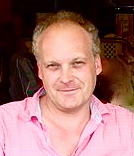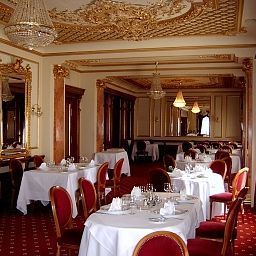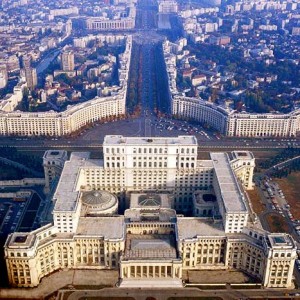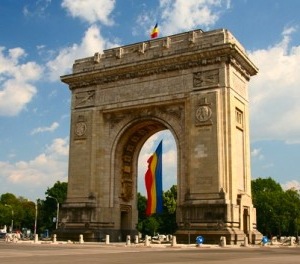Note: This novel was SHORTLISTED for the Costa First Novel Award in 2011. It was WINNER of the Wales Book of the Year Award in 2011.
‘You see that?’ Leo asked, pointing at the Palace of the People, an entire horizon’s worth of concrete, steel and marble cladding. ‘That’s the world’s biggest mausoleum. When they’ve finished building it, the whole of communism will climb in there, shut the doors, and die. They think they’re building in the city of the future. What they’ve done is build their own tomb…the new city of the dead, waiting for its tenants.’ ”
 By 1989 Nicolae Ceausescu had been the communist ruler of Romania for twenty-four years. This was to be his last year. Focusing on Ceausescu’s last hundred days, author Patrick McGuinness recreates all the forces leading to the overthrow of the government, telling his story through the eyes of an unnamed twenty-one-year-old speaker from the UK. The speaker, whose home life had been a disaster, had dropped out of college after his first year, but when his bullying father finally died, the young man applied for a foreign posting and was given a job teaching English in Bucharest, a job for which he had neither applied nor appeared for an interview.
By 1989 Nicolae Ceausescu had been the communist ruler of Romania for twenty-four years. This was to be his last year. Focusing on Ceausescu’s last hundred days, author Patrick McGuinness recreates all the forces leading to the overthrow of the government, telling his story through the eyes of an unnamed twenty-one-year-old speaker from the UK. The speaker, whose home life had been a disaster, had dropped out of college after his first year, but when his bullying father finally died, the young man applied for a foreign posting and was given a job teaching English in Bucharest, a job for which he had neither applied nor appeared for an interview.
In Bucharest his mentor, Leo O’Heix, shows him “the Paris of the East,” which now more clearly resembles “a deserted funfair.” When he takes the speaker to dinner at the elegant Capsa Hotel, where the waiters have been trained in French manners, he observes the waiters “[slicing] fillets of Chateaubriand with gentle strokes while in the shops beyond, unstacked shelves gleamed under twists of flypaper and the crimeless streets shouldered their burden of emptiness .” At the Capsa the party faithful and those who have money come to make connections, negotiate personal deals, be seen, and enjoy food not available elsewhere in the country. “It’s all here, passion, intimacy, human fellowship,” Leo tells him. “You just need to adapt to the circumstances…it’s a bit of a grey area to be honest. Actually…it’s all grey area round here,” but this is “the Romanian way,” the speaker learns, and it is adapt or get out. Leo has adapted to Romanian life completely, scorning equally the party apparatchiks and the British expats who live in a compound and spend their free time at the local pub, the Ship and Castle (better know as the Shit and Hassle). Not incidentally, Leo is also Bucharest’s biggest black-marketeer, making deals with virtually everyone and storing his plunder in the basement of the two biggest museums in Bucharest.
.” At the Capsa the party faithful and those who have money come to make connections, negotiate personal deals, be seen, and enjoy food not available elsewhere in the country. “It’s all here, passion, intimacy, human fellowship,” Leo tells him. “You just need to adapt to the circumstances…it’s a bit of a grey area to be honest. Actually…it’s all grey area round here,” but this is “the Romanian way,” the speaker learns, and it is adapt or get out. Leo has adapted to Romanian life completely, scorning equally the party apparatchiks and the British expats who live in a compound and spend their free time at the local pub, the Ship and Castle (better know as the Shit and Hassle). Not incidentally, Leo is also Bucharest’s biggest black-marketeer, making deals with virtually everyone and storing his plunder in the basement of the two biggest museums in Bucharest.
 Gradually, Bucharest comes to life through the speaker’s eyes – “a heat-beaten maze whose walls and towers melted like sugar, and where the roots of trees erupted through the pavements.” The city is being bulldozed at a rapid rate, and the old architectural monuments and historical buildings are being replaced with cheap, modern buildings, some of them with steel framing only to the third or fourth floor, the remaining floors built on top of each other, floor after floor of concrete, with all the weight borne by the bottom floors, an unparalleled structural disaster. Shop signs appear on new buildings, but the shops are empty. Hungry people wait in long lines, often discovering that though they are waiting for flour, it has run out. If they are then offered some non-food item instead, they take whatever is available. They can always barter whatever they get on their own black-markets. Most shockingly, even the headstones have disappeared from most cemeteries, appropriated and removed by the government for use in the building of the People’s Palace, since it is the only marble or appropriate stone left in the country that can be used to complete this colossal monument, begun in 1983 and second in size only to the U.S. Pentagon.
Gradually, Bucharest comes to life through the speaker’s eyes – “a heat-beaten maze whose walls and towers melted like sugar, and where the roots of trees erupted through the pavements.” The city is being bulldozed at a rapid rate, and the old architectural monuments and historical buildings are being replaced with cheap, modern buildings, some of them with steel framing only to the third or fourth floor, the remaining floors built on top of each other, floor after floor of concrete, with all the weight borne by the bottom floors, an unparalleled structural disaster. Shop signs appear on new buildings, but the shops are empty. Hungry people wait in long lines, often discovering that though they are waiting for flour, it has run out. If they are then offered some non-food item instead, they take whatever is available. They can always barter whatever they get on their own black-markets. Most shockingly, even the headstones have disappeared from most cemeteries, appropriated and removed by the government for use in the building of the People’s Palace, since it is the only marble or appropriate stone left in the country that can be used to complete this colossal monument, begun in 1983 and second in size only to the U.S. Pentagon.

The speaker finds himself growing up as he makes choices or has them made for him, and he eventually adapts to being followed everywhere. He discovers that no one is who s/he seems to be. As the speaker becomes intimately involved in the country and makes friends, he meets a group of young people who are building a “skills bank” where people barter their skills, a communist ideal in which everyone can participate. These same people are also involved in smuggling people to the Yugoslav border for the dangerous trip across the river to freedom. Though the “velvet revolution” against communism has already started elsewhere, with the Berlin Wall coming down, and Poland, Czechoslovakia, Hungary, and even Russia casting off the yoke of the Soviet Union, Ceausescu remains in power here, though his public engagements are limited to “a rotation of pygmy plenipotentiaries and micro-dignitaries” like Yasser Arafat and Slobodan Milosevic. As photographs and first person accounts of what is happening in the country make their way outside Romania to be published in Paris, the rebel movement takes heart and begins to make plans. And when factory workers in Timisoara rebel, and troops, tanks, and armored cars are sent in, the handwriting is on the wall for the speaker and all foreign residents who must decide whether to stay or to obey the directive to return home during the revolution which is on its way.
 The author does a remarkable job of recreating Bucharest, which is really the main character here, a place with incredible resilience, around which all the human characters revolve as the author connects them with the city’s history, its communist functionaries, its “flexible” morality, and its often inflexible laws and dictates. As people constantly seek (and often find) ways around the restrictions here, the reader is encouraged by the cleverness and originality with which they operate, but appalled in the same degree by the betrayals committed by some in order to advance themselves, and the violence which accompanies these betrayals. The speaker and his friends find themselves in fraught circumstances throughout the tumultuous three months leading to the fall of Ceausescu, and the drama rises inexorably. The reader, familiar with the characters, comes to know and expect them to act in particular ways, but often discovers at the last minute that someone has betrayed someone else. The author is particularly realistic in making no real value judgments about most of these characters, even those who may act in ways contrary to what most of us would consider “ethical.” In times of such crisis, who knows what any of us would do, he seems to suggest. Subtle, often humorous, and profoundly ironic, this is a unique approach to a study of a city in the midst of evolution and then revolution and its aftermath, and none of the characters here will remain unchanged. Fascinating on all levels.
The author does a remarkable job of recreating Bucharest, which is really the main character here, a place with incredible resilience, around which all the human characters revolve as the author connects them with the city’s history, its communist functionaries, its “flexible” morality, and its often inflexible laws and dictates. As people constantly seek (and often find) ways around the restrictions here, the reader is encouraged by the cleverness and originality with which they operate, but appalled in the same degree by the betrayals committed by some in order to advance themselves, and the violence which accompanies these betrayals. The speaker and his friends find themselves in fraught circumstances throughout the tumultuous three months leading to the fall of Ceausescu, and the drama rises inexorably. The reader, familiar with the characters, comes to know and expect them to act in particular ways, but often discovers at the last minute that someone has betrayed someone else. The author is particularly realistic in making no real value judgments about most of these characters, even those who may act in ways contrary to what most of us would consider “ethical.” In times of such crisis, who knows what any of us would do, he seems to suggest. Subtle, often humorous, and profoundly ironic, this is a unique approach to a study of a city in the midst of evolution and then revolution and its aftermath, and none of the characters here will remain unchanged. Fascinating on all levels.

Photos, in order: The author’s photo appears on http://en.wikipedia.org
The Capsa Restaurant is from http://www.hrs.com
The Palace of the People, begun in 1983, along with the buildings lining the Boulevard of Socialist Victory leading up to it, is the second largest building in the world (after the Pentagon). http://en.wikipedia.org
This two-tier building, originally a private home, became the headquarters of the Securitate during Ceausescu’s rule. Damaged in the 1989 uprising, it was rebuilt, in 2003, as the headquarters of the Romanian Architects Association in an odd melding of styles. http://www.ibtimes.com
Modeled after the Arc de Triomphe in Paris, this arc in Bucharest symbolizes the city’s status during the middle of the century as “the Paris of Eastern Europe.”
ARC: Bloomsbury USA
